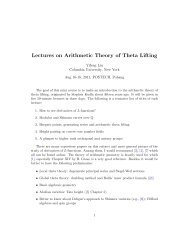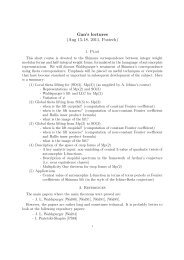MODULARITY LIFTING THEOREMS - NOTES FOR POSTECH ...
MODULARITY LIFTING THEOREMS - NOTES FOR POSTECH ...
MODULARITY LIFTING THEOREMS - NOTES FOR POSTECH ...
Create successful ePaper yourself
Turn your PDF publications into a flip-book with our unique Google optimized e-Paper software.
12 TOBY GEE<br />
want to prove that ρ is modular. For this to be true, we will have to assume<br />
some conditions. Firstly:<br />
◦ ρ is unramified at almost all primes, and is de Rham at places<br />
dividing p, with distinct Hodge-Tate weights.<br />
◦ ρ is odd, i.e. det ρ(cv) = −1 for any complex conjugation cv.<br />
These conditions are conjecturally enough. However, we can’t prove a theorem<br />
anything like as strong as this. There are a number of assumptions<br />
that we need to make that appear to be intrinsic to the method.<br />
◦ ρ is modular, say ρ ∼ = ¯rp(π).<br />
◦ ρ|G F (ζp) is irreducible.<br />
◦ π has the same weight as ρ, in a sense that we will make precise<br />
below.<br />
There is another assumption that we will make that can be considerably<br />
relaxed, but not as yet removed.<br />
◦ If v|p is a place of F , then Fv/Qp is unramified, and the Hodge-Tate<br />
weights of ρ are all {0, k − 1} with 0 ≤ k ≤ p − 1. Furthermore πv<br />
is unramified for all v|p, and π has weight (k, 0).<br />
We begin by making a number of simplifications. Firstly, we use Grothendieck’s<br />
monodromy theorem, local-global compatibility, and solvable base change,<br />
which together show that we may assume that:<br />
◦ At every finite place v ∤ p of F , ρ|GFv is either unramified, or has<br />
unipotent ramification.<br />
◦ Each πv is either unramified or is Sp2(χ) with χ unramified.<br />
Less obviously, but explained in Ken Ribet’s talk, we can assume that<br />
◦ Each πv is unramified.<br />
[Sketch: base change so that if v is a place with πv Steinberg, than Nv ≡ 1<br />
(mod p). Then produce a congruence between the Steinberg and a ramified<br />
principal series, and then make another base change to replace this with an<br />
unramified principal series.] For the method we’re going to use, we will also<br />
make a further base change and assume that:<br />
◦ If v ∤ p is a place at which ρ|GFv is ramified, then Nv ≡ 1 (mod p),<br />
and ρ(GFv) = 1.<br />
We can finally also assume that det ρ = det rp(π); the ratio of these characters<br />
is everywhere unramified and residually trivial, thus has finite p-power<br />
order, and in particular is necessarily trivial on each complex conjugation,<br />
so can be trivialised by base change.<br />
By a standard argument using the Baire category theorem and the fact<br />
that GF is compact, we may assume that ρ : GF → GL2(K), K/Qp finite.<br />
Again using the compactness of GF , after conjugation we may assume that<br />
ρ : GF → GL2(O), where O is the ring of integers of K, with maximal ideal λ<br />
and residue field O/λ = k. We will sometimes assume that K is sufficiently




